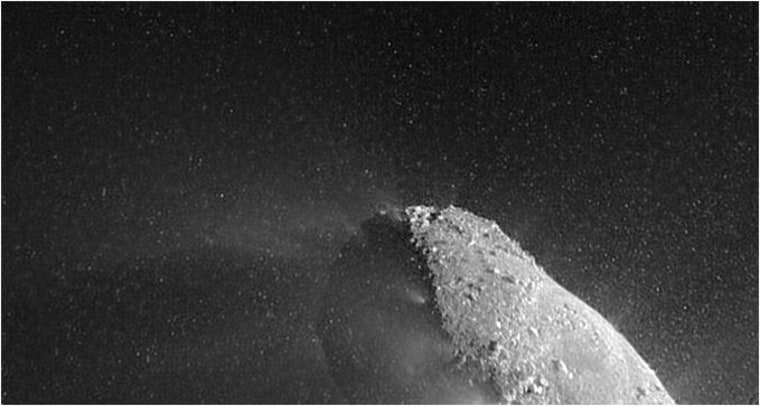Talk about bad weather.
A NASA spacecraft found itself hurtling through an unexpected cosmic ice storm during a recent flight past a comet, but came out unharmed, scientists reported Thursday.
Speeding at 27,000 mph, the Deep Impact craft flew within 435 miles of comet Hartley 2 on Nov. 4 — only the fifth time a comet had been viewed up close.
New images from the flyby revealed a blizzard of white specks surrounding the nearly 1.5-mile-long (2-kilometer-long) peanut-shaped comet.
"Those are not stars. Those are all chunks of ice," said chief investigator Michael A'Hearn of the University of Maryland.
The ice cloud surrounding Hartley 2 was driven by jets of carbon dioxide shooting out from the comet's interior, scientists said. As the carbon dioxide spewed out, it carried with it tons of ice ranging from the size of golf balls to basketballs.
Though Deep Impact was a safe distance away, it apparently got hit nine times by icy particles weighing less than a snowflake. The craft was not damaged, said project manager Tim Larson of the NASA Jet Propulsion Laboratory, which managed the $42 million mission.
Comets are considered time capsules of the solar system, icy leftovers from when it formed about 4.5 billion years ago. Studying comets could shed light on how Earth and the planets formed and evolved.
That the comet ice storm was created by carbon dioxide jets came as a surprise to researchers, who said it could change the way they think about these nomadic icy bodies.
Carbon dioxide "was never thought to be the main driver of comet activity. That role has been reserved for water," said astronomer David Jewitt of the University of California at Los Angeles, who had no part in the mission.
Since the encounter, mission scientists have been analyzing the flood of data coming down at a rate of 3,000 images a day. They have yet to determine when the ice storm began and how long it will last.
Hartley 2 is the second comet visited by Deep Impact. In 2005, it set off cosmic fireworks when it released a probe that crashed into comet Tempel 1. The $333 million collision gave scientists their first peek inside a comet.
Deep Impact will continue observing Hartley 2 until Thanksgiving as NASA decides whether to recycle it for a third mission. The craft does not have enough fuel to perform another flyby.
